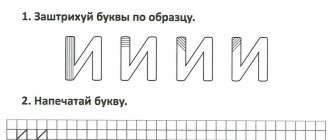Preparation for teaching literacy to children of senior preschool age
Key principles for preparing for literacy
Before moving to secondary school, literacy learning is usually structured as follows: Preparing to learn to read and write (Preschool education) → Ready to learn reading and writing (Preschool education) → Learning to read and write (Primary education) → Developing reading and writing skills letters (Primary education). The basis for successfully developing readiness to become familiar with literacy is the study of sound analysis and the development of graphic skills.
What needs to be taught to a child in preparation for mastering reading and writing:
- Identify sounds that occur frequently in words.
- Name words according to a specific phonemic feature.
- Carry out a sound analysis of words of 3-5 sounds during the modeling process.
- Correlate the spoken word with the diagram of its sound composition.
- In accordance with the game rules, change the sound composition of a word, name words with a certain sound, words of a given sound structure.
- Select words that are similar and opposite in meaning.
- When describing objects, use words that characterize their properties and qualities.
- Compose short stories on topics close to children.
- Compose a story based on a series of plot pictures.
- Participate in a group conversation and ask questions.
You will learn about the features of teaching reading and writing to preschoolers in our materials:
“Let them teach reading at school!”
“Developing preschool children: preparing the hand for writing. Where to begin?"
Features of the educational complex “Paths” and “Pre-school time”
The Russian Textbook Corporation presents the courses “Paths” (for systemic preschool education) and “Pre-school time” (for short-term groups and for preparing children at schools). The projects have already earned high praise from teachers. The publications present a methodology for preparing for learning to read and write, developed by a well-known specialist in the field of preschool and primary education, Lidia Zhurova, based on the popular method of Daniil Elkonin. The method involves preparation through five stages:
The first stage (and the most important). Skill training:
- intonationally highlight the sound in a word;
- name words with a given sound;
- highlight and name the first sound in a word;
- distinguish between hard and soft paired consonants (without introducing terminology).
Second phase. Teaching children the action of the sound composition of a word. During the sound analysis of words, the sound composition of the word is modeled using chips.
Third stage. Introducing letters that represent vowel sounds.
Fourth stage. Acquaintance with letters denoting consonants and mastering the reading mechanism.
Fifth stage. Working out the reading mechanism using material from the entire alphabet.
Let's take a closer look at how to build a sound analysis.
Let's learn to speak correctly. 3-4 years. Child benefit
The manual presents tasks on speech development aimed at clarifying the content of classes with children in the 2nd junior group of a preschool educational organization. The manual complies with the Federal State Educational Standard for Preschool Education (2014). The texts in the manual are intended to be read to children by adults.
Buy
Sound Analysis Action Operations
- Pronouncing a word while simultaneously moving the pointer along the sound pattern (the pronunciation and hand movement are being coordinated).
- Pronouncing a word with intonation highlighting the first sound.
- Pronunciation of the first sound is isolated, as it is heard in the word.
- Designation of sound with a chip (the chip is placed in the first cell).
- Continuation of work with subsequent sounds of the word in the indicated logic: the child points the pointer according to the diagram, pronounces the entire word, holds the pointer in the second cell, intonationally highlights the second sound, names the second sound in isolation and fixes it with a chip, then also highlights the third sound.
- After marking the last sound with a chip, it is mandatory to read the entire word.
The first stage - familiarization with sounds - is very important.
If a new student appears in a group several months before the end of preschool education, then the teacher must make a choice: immediately teach such a child to read or start preparing him? The right decision would be to choose preparation, since knowledge of phonemes will be useful to the child at school. #ADVERTISING_INSERT#






